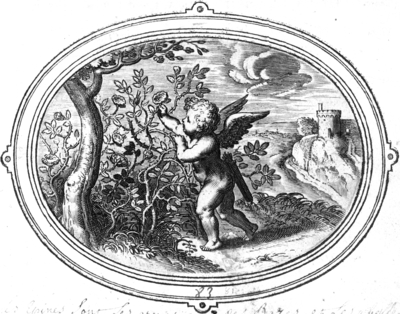Otto Vaenius, Amorum emblemata (1608)
Table of contents ↑Armat spina rosas, mella tegunt apes [81]

Translations
 |
Claudianus, Fescennina dicta Honorio Augusto et Mariae (=Carmina maiora 11-14) 14, 10.
Doornen wapenen de roos en bijen beschermen hun honing. |
 |
Claudianus, Fescennina dicta Honorio Augusto et Mariae (=Carmina maiora 11-14) 14, 10.
Thorns arm the rose and bees find a defence for their honey. [tr. M. Platnauer, Loeb 1, p. 237] |
Sources and parallels
- Armat spina rosas, mella tegunt apes [46]
 (in: Otto Vaenius, Emblemata aliquot selectiora amatoria (1618)
(in: Otto Vaenius, Emblemata aliquot selectiora amatoria (1618) )
[Compare
)
[Compare ]
]
- Ayres, Emblemata amatoria
 , embl. 17
, embl. 17 - The same theme illustrated with bees: Alciato, Book of Emblems
 , embl. 112
, embl. 112 - Or perhaps: Alciato, Book of Emblems
 , embl. 113
, embl. 113 -
Love compared to plucking roses in: VVaerom ghy meer als ick? [9]
 (in: Pieter Cornelisz. Hooft, Emblemata amatoria (1611)
(in: Pieter Cornelisz. Hooft, Emblemata amatoria (1611) )
[Compare
)
[Compare ]
]
-
Same motto, pictura slightly modified: Armat spina Rosas mella tegunt apes. [20]
 (in: anonymous, Emblemata amatoria (1690)
(in: anonymous, Emblemata amatoria (1690) )
[Compare
)
[Compare ]
]
-
Parallel for the main pictorial elements (mirrored), the Latin motto and the French motto (not exact) in: Un Amour qui cueille des Fleurs au milieu d’un Buisson
 (in: Daniel de la Feuille, Devises et emblemes (1691)
(in: Daniel de la Feuille, Devises et emblemes (1691) )
[Compare
)
[Compare ]
]
References, across this site, to this page:
- Quod iuvat exiguum est. [19]
 (in: Jacob Cats, Sinne- en minnebeelden (1627)
(in: Jacob Cats, Sinne- en minnebeelden (1627) )
)
- Armat spina Rosas mella tegunt apes. [20]
 (in: anonymous, Emblemata amatoria (1690)
(in: anonymous, Emblemata amatoria (1690) )
)
- Un Amour qui cueille des Fleurs au milieu d’un Buisson
 (in: Daniel de la Feuille, Devises et emblemes (1691)
(in: Daniel de la Feuille, Devises et emblemes (1691) )
)
- VVaerom ghy meer als ick? [9]
 (in: Pieter Cornelisz. Hooft, Emblemata amatoria (1611)
(in: Pieter Cornelisz. Hooft, Emblemata amatoria (1611) )
)
- Armat spina rosas, mella tegunt apes [46]
 (in: Otto Vaenius, Emblemata aliquot selectiora amatoria (1618)
(in: Otto Vaenius, Emblemata aliquot selectiora amatoria (1618) )
)

